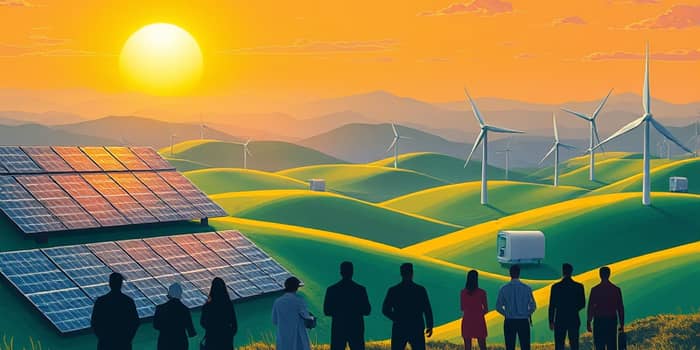
As the world grapples with climate change and energy security, 2025 marks a pivotal year in the global transition to clean power. Surpassing long-held norms, investors are channeling unprecedented capital into renewable technologies, reshaping markets and signaling a profound shift in economic priorities. Global energy investment reaches record as stakeholders embrace sustainable solutions.
Analysts predict that total global energy investment will soar to an all-time high of $3.3 trillion in 2025. This surge reflects a broader realignment of capital, as Clean energy attracts $2.2 trillion investment, nearly double that allocated to upstream oil and gas.
Within this historic allocation, solar photovoltaics and wind power dominate new deployments, while nuclear energy enjoys renewed interest, with projected spending exceeding $70 billion—a 50% rise over five years. Historical growth underscores this momentum: renewable investment climbed from $348 billion in 2020 to $499 billion by 2022, and in 2023 solar and wind funding jumped 75% year-on-year to $200 billion.
The table above illustrates how solar PV and storage technologies command the majority of cleantech funding, reinforcing the sector’s rapid expansion and investor confidence.
Solar PV remains the single largest target for global energy capital. Accounting for nearly half of all cleantech investments and two-thirds of new capacity installations, solar projects are expected to receive $450 billion in 2025 alone. Solar PV dominates global capital flows, driven by dramatic cost reductions—solar panel prices fell by 69% between 2013 and 2022.
Wind follows closely, with both onshore and offshore projects benefiting from technological advances and economies of scale. Meanwhile, other renewable sources such as hydropower, biomass, and marine energy face stagnating investment, underscoring the market’s concentration on high-growth segments.
Governments worldwide have enacted policies to accelerate the green transition. In the United States, the Inflation Reduction Act (IRA) and Infrastructure Investment and Jobs Act (IIJA) have unlocked billions in tax credits and grants, catalyzing unprecedented solar, storage, wind, and hydrogen deployments. Internationally, feed-in tariffs and renewable portfolio standards are driving similar momentum across Europe, Asia, and Latin America.
Technological innovations further bolster growth. AI-driven grid planning transforms networks by optimizing renewable generation forecasting and distribution. Meanwhile, Long-duration storage installations set to double in 2025, enhancing grid reliability and smoothing supply fluctuations caused by variable wind and solar output.
Investor confidence in clean energy has never been higher. Surveys indicate that over 93% of industry professionals express strong optimism about the sector’s future, with 60.1% ranking their confidence at the very top. Many cite Sustainable finance shapes investment strategies, as climate risk considerations and ESG mandates become integral to portfolio decisions.
Capital now flows through diverse channels—venture capital, private equity, green bonds, and debt issuance—targeting both early-stage innovators and large-scale infrastructure. Despite current annual clean energy investment hitting $1.9 trillion, achieving Net Zero Emissions goals will require scaling to $5.3 trillion per year by 2035, presenting ample opportunities for further capital deployment.
Despite remarkable progress, the transition faces notable hurdles. Grid infrastructure in many regions remains outdated, limiting the integration of variable renewables. Permitting delays and regulatory complexity hinder project timelines, while regional equity concerns underscore the need for inclusive planning to ensure all communities benefit from new investments.
Addressing these challenges will require coordinated action among governments, utilities, investors, and technology providers. By streamlining regulations, investing in smart grid upgrades, and fostering local workforce development, stakeholders can sustain the green momentum and unlock the next wave of decarbonization.
In the face of climate urgency and evolving market dynamics, 2025 stands as a transformative milestone. With record-breaking investments, technological breakthroughs, and unwavering investor optimism, the path to a sustainable energy future is clearer than ever. As capital flows and policies align, the clean energy revolution promises not only environmental benefits but also robust economic returns, driving a more resilient and equitable world for generations to come.
References













